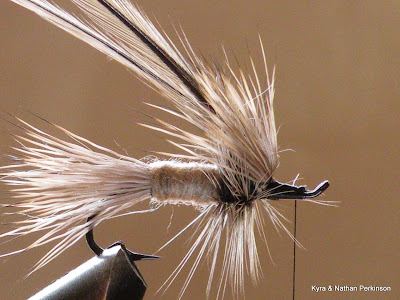My Aide-de-Camp
&
A Nice Crayfish Fly
The unusually warm weather allowed us to get out a little bit already this year. My oldest son, Caleb, has already shown me up on the water. Although he is only three, he seems to have mastered the roll cast better than his old man.
Probably due to the fact that I spent years fly fishing small, brush- and tree-lined streams, I developed the habit of always casting with a sidearm motion. That casting motion has become so automatic that I even catch myself casting sidearm in open fields and on the beach! I occasionally force myself to cast overhead, but it requires extrodinary mental discipline and generally leads to worse casts than the sidearm. I suppose it does not hurt anything, as I usually fare alright in the long run.
In addition to casting sidearm, I also avoid roll casting most of the time. Instead, I usually allow my cast to drift downstream and use the line on the water to flick another cast upstream, directing the cast with the rod tip. I realize that these heinous acts of angling heresy should not be mentioned in polite company, but we're all adults here, right?
Anyway, I took Caleb to a local pond where some friendly park rangers sometimes relocate big trout for kids to catch and release. I tied on a size 6 Stimulator, cast it out and handed the rod to Caleb. He pulled in a bit of line, raised the rod tip, dropped it to the water and unrolled a perfect cast. As my jaw hung in amazement, he did it again. Did I mention that he is three?
I suppose the lesson to take home from this experience is that bad habits are learned rather than ingrained from birth. Now if I could just get him to tie up some size 22 Blue-Wing Olives for me...
A Nice Crayfish Fly
Here is a nice crayfish fly that you can try the next time you are fishing. I have tied and fished a lot of different crayfish flies over the years. My personal best smallmouth came on a crayfish fly in southwest Indiana several years ago. My first published magazine article was about a crayfish fly, as well. Although I tend to lean toward the "more action, less realism" school of thought, this one looks good and has enough action to satisfy grouchy smallmouth.
Realistic Crayfish
Hook: Size 6 streamer
Thread: Orange 140 denier
Thorax
Claws: Neck feathers from cock pheasant
Antennae: Fox squirrel tail fibers
Front carapace: Natural deer hair (color orange with a Sharpie when fly is complete)
Legs: Brown hackle, clipped on top and bottom
Thorax: Orange blended squirrel dubbing
Tail
Weight: Lead wire or substitute on tail only
Rib: Copper wire on tail only
Tail carapace: Natural deer hair (color orange with a Sharpie when fly is complete)
Tail underbody: Orange blended squirrel dubbing
Bind down the deer hair and clip the ends long to make a tip-top for the tail.
Enjoy!
 |
| "How did you do that again, kid?" |













